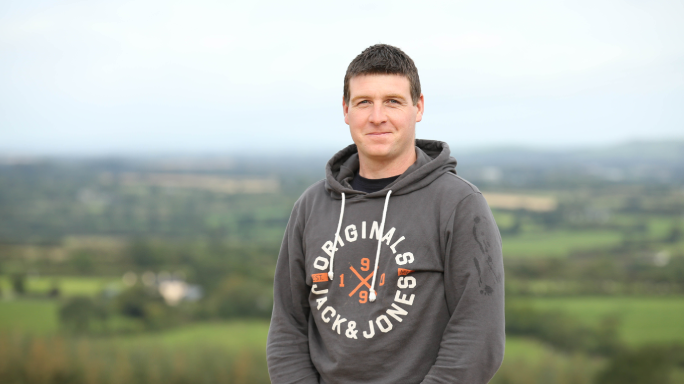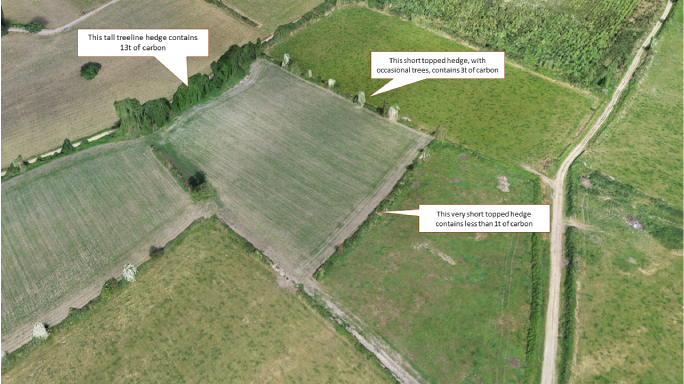Remote Surveys of carbon and biodiversity Tirlán Autumn 2024

Dr. Siobhán Kavanagh and Sandra Hayes report on the remote surveys of carbon and biodiversity.
Quantifying Habitats and Carbon Stored on Signpost Farms
Two of the goals for Signpost farms is to protect and enhance carbon storage and biodiversity on the farm. Biodiversity on the farms is assessed by the quantity and quality of habitats and Carbon is stored on the farm in the soil and in the plants growing on the farm; the biomass.
This project sets out to establish the % biodiversity on the Signpost farms and the carbon stored. In the winters of 2022/2023 and 2023/24 all Teagasc Tirlán Signpost farms were surveyed using drone mounted cameras and LIDAR. The colour imagery taken by the drone gives a snapshot of the farm land cover and habitats. The LIDAR is a scanning technology the sends out laser pulses and measures the time it takes for the pulse to be reflected from the surface back to the drone (similar to RADAR), allowing a 3D picture of the farm to be built up of millions of points.
Habitats as % of total area
The data collected from the LIDAR points are then interpreted by a geospatial specialist to create a high resolution biodiversity map. There are 45 possible labels with land covers including BUILDINGS, IMPROVED GRASSLAND and CROPS. Habitats include HEATH, SCRUB and WET GRASSLAND. The habitats as a percentage of the total area are calculated and displayed as a bar chart and as a total percentage (this is not the same calculation as space for nature). Values range from 3% of the farm to more than 15%.
These maps provide a baseline for the farmer and advisor. They show the structure of the habitat assets on the farm and help direct discussion about where and how to improve. For example, showing where a short length of new hedgerow could go that would improve the overall connectivity of the farm habitats whilst also helping potentially to reduce run-off into water courses.
Carbon stored
The maps are also used for the calculation of carbon stored in the woody biomass of the farm; hedgerows, woodland, forest, treelines, scrub and solo trees. This is done by calculating the exact volume of a hedgerow and using equations developed in Teagasc to convert that volume into biomass and thus tonnes of carbon.
It is important to think of volume when assessing how much carbon a hedgerow contains not its length. A short, tightly managed hedgerow will contain much less carbon (maybe as little as a 10th) than the same length of a wider, taller hedgerow that has also trees within it. It’s important to note that this is carbon stored over the life of the farm. It is not the carbon sequestered annually by the farm biomass.
Steven Fitzgerald
Steven’s farm was flown by the LIDAR equipment back in 2023. Below is just one example of hedgerows on this farm. In one particular field there are substantial differences in the carbon stored in hedgerows. A tall treelined hedge with considerable biomass contains 13 tonnes of carbon. While on the other side of the field, a very short topped hedge contains less than 1 tonne of carbon. There is substantial opportunity to increase the carbon stored in this hedgerow by the way Steven and all farmers maintain their hedges. Correct management of existing hedges can a greater capacity to increase carbon than new hedge planting alone.

Steven manages the hedgerow growth on the farm by side trimming and allowing as much as possible for the hedges to mature and gain height as much as possible. Any of the tree lined hedges are left undisturbed and only dangerous branches are trimmed if required. Whitethorn and blackthorn hedges are side trimmed when required and allowed have a wide a base as possible and cut into an A shape. As well as being excellent carbon stores these types of hedges are great shelter belts for the grazing livestock on the farm. As the farm is in derogation Steven has allowed white thorn saplings to grow into mature trees in the hedgerows as well. A hedge should be a wildlife larder for most of the year - providing flowers and fruits for insects, birds and small mammals. As some of the hedges are a mixture of whitethorn, trees and furze it provides a huge variety in structure, density, connectivity and biodiversity to support wildlife on this farm was well as storing carbon.
Dr. Siobhán Kavanagh, Communications & Engagement Specialist Signpost Programme
Sandra Hayes Coordinator of the Teagasc Tirlán Future Farm Programme
First Published 16 October 2024